Framing the Retirement Planning Behavior Model towards Sustainable Wellbeing among Youth: The Moderating Effect of Public Profiles
Abstract
1. Introduction
2. Literature Review
2.1. Financial Literacy
2.2. Social Influence
2.3. Saving Attitude
2.4. Goal Clarity
2.5. Respondent’s Age
2.6. Gender
2.7. Status
2.8. Education
2.9. Income
3. Research Methodology
3.1. Sample Size and Measures
3.2. Data Analysis Method
3.3. Assessment of Common Method Bias
4. Findings
4.1. Descriptive Statistics
4.2. Inference Statistics
4.3. Reliabilities and Validities
4.4. Path Analysis
4.5. Measurement Invariance
4.6. Interaction Effect
Interaction Effect (Moderating Role of Gender)
4.7. Interaction Effect (Moderating Role of Age)
4.8. Interaction Effect (Moderating Role of Status)
4.9. Interaction Effect (Moderating Role of Education)
4.10. Interaction Effect (Moderating Role of Income)
5. Discussion
6. Conclusions
Author Contributions
Funding
Conflicts of Interest
References
- Department of Statistics Malaysia. Key Statistics of Labour Force in Malaysia. June 2020. Available online: https://www.dosm.gov.my/v1/index.php?r=column/cthemeByCat&cat=124&bul_id=NXU1dHdlMFFDbm53V0NhYWxpNFE0UT09&menu_id=U3VPMldoYUxzVzFaYmNkWXZteGduZz09 (accessed on 22 August 2020).
- Habib, S. Counting on the Nest Egg. 2007. Available online: https://www.thestar.com.my/news/nation/2007/05/27/counting-on-the-nest-egg (accessed on 19 July 2013).
- Moorthy, M.K.; Durai, T.; Chelliah, L.; Sien, C.S.; Leong, L.C.; Kai, N.Z.; Teng, W.Y. A Study on the retirement planning behaviour of working individuals in Malaysia. Int. J. Acad. Res. Econ. Manag. Sci. 2012, 1, 54. [Google Scholar]
- Ibrahim, D.; Isa, Z.M.; Ali, N. Malaysian savings behavior towards retirement planning. In Proceedings of the 2012 International Conference on Economics Marketing and Management, Hong Kong, China, 5–7 January 2012. [Google Scholar]
- Lu, T.J.; Mitchell, O.; Utkus, S.; Young, J. Borrowing from the Future: 401 (k) Plan Loans and Loan Defaults (No. w21102); National Bureau of Economic Research: Cambridge, MA, USA, 2015.
- Munnell, A.H.; Hou, W.; Webb, A.; Li, Y. How Has the Shift to 401 (k) Plans Affected Retirement Income? 2017. Available online: https://crr.bc.edu/briefs/how-has-the-shift-to-401k-plans-affected-retirement-income/ (accessed on 21 August 2020).
- Samwick, A.A.; Skinner, J. How Will 401(k) Pension Plans Affect Retirement Income? Am. Econ. Rev. 2004, 94, 329–343. [Google Scholar] [CrossRef]
- Vaghefi, N.; Kari, F.B.; Talib, M.A. Poverty and Income Replacement Profile among EPF Retiree in Malaysia. Soc. Indic. Res. 2016, 132, 1065–1078. [Google Scholar] [CrossRef]
- EPF—Employees Provident Fund. EPF Sets RM228,000 as Minimum Target Savings at Age 55. 2016. Available online: https://www.kwsp.gov.my/en/-/epf-sets-rm228-000-as-minimum-target-savings-at-age-55 (accessed on 15 May 2020).
- Samad, S.A.; Mansor, N. Population ageing and social protection in Malaysia. Malays. J. Econ. Stud. 2017, 50, 139–156. [Google Scholar]
- Kim, J.; Kwon, J.; Anderson, E.A. Factors related to retirement confidence: Retirement preparation and workplace financial education. J. Financ. Couns. Plan. 2005, 16, 1–19. [Google Scholar]
- Kenanga Investors. 50% Retirees Exhausted Their Savings within Five Years of Retirement, How Can You Avoid This? 2015. Available online: https://www.kenangainvestors.com.my/KIB/KIB.Application.Web/KIBFundsAdmin/images/50_Retirees_Exhausted.pdf (accessed on 5 May 2020).
- World Bank. Financial Inclusion in Malaysia: Distilling Lessons for Other Countries. 2017. Available online: http://documents1.worldbank.org/curated/en/703901495196244578/pdf/115155-WP-PUBLIC-GFM08-68p-FIpaperwebversion.pdf (accessed on 12 May 2020).
- Sabri, M.F.; Juen, T.T. The Influence of Financial Literacy, Saving Behaviour, and Financial Management on Retirement Confidence among Women Working in the Malaysian Public Sector. Asian Soc. Sci. 2014, 10, 40. [Google Scholar] [CrossRef]
- Kock, H.; Folk, J.Y. Expected retirement age: A determinant of financial planning preparation in Malaysia. Afr. J. Bus. Manag. 2011, 5, 9370. [Google Scholar]
- Tan, H.K. Financial Planning for Post-Retirement among Urban Malaysians in Klang Valley. Ph.D. Thesis, University of Malaya, Kuala Lumpur, Malaysia, 2015. [Google Scholar]
- Sabri, M.F.; Falahati, L.F. Predictors of Financial Well-Being among Malaysian Employees: Examining the Mediate Effect of Financial Stress. J. Emerg. Econ. Islam. Res. 2013, 1, 61–76. [Google Scholar] [CrossRef]
- Hunt, L. Planning for retirement. The Star Online. 2009. Available online: https://www.thestar.com.my/business/business-news/2009/04/04/planning-for-retirement (accessed on 23 August 2020).
- Pai, Y. Comparing Individual Retirement Accounts in Asia: Singapore, Thailand, Hong Kong and PRC (China). 2006. Available online: http://documents1.worldbank.org/curated/en/922941468101940975/pdf/37432rev.pdf (accessed on 22 July 2020).
- Theong, M.J.; Osman, A.F.; Yap, S.F. Household Indebtedness: How Global and Domestic Macro-Economic Factors Influence Credit Card Debt Default in Malaysia. Inst. Econ. 2018, 10, 37–56. [Google Scholar]
- Wong, J.Y.; Earl, J.K. Towards an integrated model of individual, psychosocial, and organizational predictors of retirement adjustment. J. Vocat. Behav. 2009, 75, 1–13. [Google Scholar] [CrossRef]
- Topa, G.; Lunceford, G.; Boyatzis, R.E. Financial Planning for Retirement: A Psychosocial Perspective. Front. Psychol. 2018, 8, 2338. [Google Scholar] [CrossRef] [PubMed]
- Hira, T.K.; Rock, W.L.; Loibl, C. Determinants of retirement planning behaviour and differences by age. Int. J. Consum. Stud. 2009, 33, 293–301. [Google Scholar] [CrossRef]
- Hung, A.; Parker, A.M.; Yoong, J. Defining and Measuring Financial Literacy. Working Paper: Rand Labor and Population. 2009. Available online: https://www.rand.org/content/dam/rand/pubs/working_papers/2009/RAND_WR708.pdf (accessed on 9 May 2020).
- Lusardi, A.; Mitchell, O.S. Financial literacy and retirement preparedness: Evidence and implications for financial education programs. Bus. Econ. 2007, 42, 35–44. [Google Scholar] [CrossRef]
- Lusardi, A.; Mitchell, O.S. Financial literacy and retirement planning in the United States. J. Pension Econ. Financ. 2011, 10, 509–525. [Google Scholar] [CrossRef]
- Lusardi, A.; Mitchell, O.S. The Economic Importance of Financial Literacy: Theory and Evidence. J. Econ. Lit. 2014, 52, 5–44. [Google Scholar] [CrossRef]
- Beshears, J.; Choi, J.J.; Laibson, D.; Madrian, B.C.; Milkman, K.L. The Effect of Providing Peer Information on Retirement Savings Decisions. J. Finance 2015, 70, 1161–1201. [Google Scholar] [CrossRef]
- Van Dalen, H.P.; Henkens, K.; Schippers, J. How do employers cope with an ageing workforce? Views from employers and employees. Demogr. Res. 2010, 22, 1015–1036. [Google Scholar] [CrossRef]
- Bailey, J.J.; Nofsinger, J.R.; O’Neill, M. A Review of Major Influences on Employee Retirement Investment Decisions. J. Financial Serv. Res. 2003, 23, 149–165. [Google Scholar] [CrossRef]
- Duflo, E.; Saez, E. The Role of Information and Social Interactions in Retirement Plan Decisions: Evidence from a Randomized Experiment. Q. J. Econ. 2003, 118, 815–842. [Google Scholar] [CrossRef]
- Brown, J.R.; Kling, J.R.; Mullainathan, S.; Wrobel, M.V. Why don’t people insure late-life consumption? A framing explanation of the under-annuitization puzzle. Am. Econ. Rev. 2018, 98, 304–309. [Google Scholar] [CrossRef]
- Lerner, J.; Malmendier, U. With a Little Help from My (Random) Friends: Success and Failure in Post-Business School Entrepreneurship. Rev. Financial Stud. 2013, 26, 2411–2452. [Google Scholar] [CrossRef]
- Mansor, M.F.; Hong, C.C.; Abu, N.H.; Shaari, M.S. Demographic Factors Associated with Retirement Planning: A Study of Employees in Malaysian Health Sectors. Asian Soc. Sci. 2015, 11, 108–116. [Google Scholar] [CrossRef]
- Earl, J.K.; Bednall, T.C.; Muratore, A.M. A Matter of Time: Why Some People Plan for Retirement and Others Do Not. Work. Aging Retire. 2015, 1, 181–189. [Google Scholar] [CrossRef]
- Stawski, R.S.; Hershey, D.A.; Jacobs-Lawson, J.M. Goal Clarity and Financial Planning Activities as Determinants of Retirement Savings Contributions. Int. J. Aging Hum. Dev. 2007, 64, 13–32. [Google Scholar] [CrossRef]
- Hogarth, J.M.; Anguelov, C.E.; Lee, J. Why Don’t Households Have a Checking Account? J. Consum. Aff. 2005, 38, 1–34. [Google Scholar] [CrossRef]
- Hershey, D.A.; Jacobs-Lawson, J.M.; McArdle, J.J.; Hamagami, F. Psychological Foundations of Financial Planning for Retirement. J. Adult Dev. 2007, 14, 26–36. [Google Scholar] [CrossRef]
- Chou, K.-L.; Yu, K.-M.; Chan, W.-S.; Wu, A.M.; Zhu, A.Y.F.; Lou, V.W. Perceived retirement savings adequacy in Hong Kong: An interdisciplinary financial planning model. Ageing Soc. 2014, 35, 1565–1586. [Google Scholar] [CrossRef]
- Zacher, H. Older job seekers’ job search intensity: The interplay of proactive personality, age and occupational future time perspective. Ageing Soc. 2012, 33, 1139–1166. [Google Scholar] [CrossRef]
- Petkoska, J.; Earl, J.K. Understanding the influence of demographic and psychological variables on retirement planning. Psychol. Aging 2009, 24, 245–251. [Google Scholar] [CrossRef]
- Jacobs-Lawson, J.M.; Hershey, D.A.; Neukam, K.A. Gender Differences in Factors that Influence Time Spent Planning for Retirement. J. Women Aging 2004, 16, 55–69. [Google Scholar] [CrossRef]
- Wykle, M.L.; Whitehouse, P.J.; Morris, D.L. (Eds.) Successful Aging through the Life Span: Intergenerational Issues in Health; Springer Publishing Company: Berlin/Heidelberg, Germany, 2004. [Google Scholar]
- Baistaman, J.; Awang, Z.; Afthanorhan, A.; Rahim, M.Z.A. Developing and validating the measurement model for financial literacy construct using confirmatory factor analysis. Humanit. Soc. Sci. Rev. 2020, 8, 413–422. [Google Scholar] [CrossRef]
- Liebman, J.B.; Luttmer, E.F.P. Would People Behave Differently If They Better Understood Social Security? Evidence from a Field Experiment. Am. Econ. Journal: Econ. Policy 2015, 7, 275–299. [Google Scholar] [CrossRef]
- Croy, G.; Gerrans, P.; Speelman, C.P. The role and relevance of domain knowledge, perceptions of planning importance, and risk tolerance in predicting savings intentions. J. Econ. Psychol. 2010, 31, 860–871. [Google Scholar] [CrossRef]
- Lusardi, A.; Mitchell, O.S. Older Women’s Labor Market Attachment, Retirement Planning, and Household Debt. SSRN Electron. J. 2016. [Google Scholar] [CrossRef]
- Meisenberg, G. Gender Differences in School Achievement across Cultures: An Analysis of Results from PISA 2000–2012. Mank. Q. 2016, 57, 227–251. [Google Scholar] [CrossRef]
- Saw, G.K. Patterns and trends in achievement gaps in Malaysian Secondary Schools (1999–2011): Gender, ethnicity, and socioeconomic status. Educ. Res. Policy Pract. 2016, 15, 41–54. [Google Scholar] [CrossRef]
- Osman ME, T.; Al Khamisi, H.; Al Barwani, T.; Al Mekhlafi, A. EFL Reading Achievement: Impact of Gender and Self-efficacy Beliefs. Int. J. Learn. Teach. Educ. Res. 2016, 15, 54–73. [Google Scholar]
- Hyde, J.S.; Linn, M.C. Diversity: Enhanced: Gender Similarities in Mathematics and Science. Science 2006, 314, 599–600. [Google Scholar] [CrossRef]
- Talaga, J.A.; Beehr, T.A. Are there gender differences in predicting retirement decisions? J. Appl. Psychol. 1995, 80, 16. [Google Scholar] [CrossRef]
- Henkens, C. Retirement intentions and spousal support: A multi-actor approach. J. Gerontol. Ser. B 1999, 54, S63–S73. [Google Scholar] [CrossRef]
- Lee, W.K.M.; Law, K.W.-K. Retirement Planning and Retirement Satisfaction: The Need for a National Retirement Program and Policy in Hong Kong. J. Appl. Gerontol. 2004, 23, 212–233. [Google Scholar] [CrossRef]
- Joo, S.H.; Pauwels, V. Factors Affecting Workers’ Retirement Confidence: A Gender Perspective. J. Financ. Couns. Plan. 2002, 13, 1–10. [Google Scholar]
- Lusardi, A.; Mitchell, O.S.; Curto, V. Financial Literacy among the Young. J. Consum. Aff. 2010, 44, 358–380. [Google Scholar] [CrossRef]
- Faulkner, A.E. Financial Literacy Education in the United States: Library Programming versus Popular Personal Finance Literature. Ref. User Serv. Q. 2017, 56, 116. [Google Scholar] [CrossRef]
- Boisclair, D.; Lusardi, A.; Michaud, P.C. Financial literacy and retirement planning in Canada. J. Pension Econ. Financ. 2017, 16, 277–296. [Google Scholar] [CrossRef]
- Arano, K.; Parker, C.; Terry, R. Gender-based risk aversion and retirement asset allocation. Econ. Inq. 2010, 48, 147–155. [Google Scholar] [CrossRef]
- Hair, J.; Hollingsworth, C.L.; Randolph, A.B.; Chong, A.Y.L. An updated and expanded assessment of PLS-SEM in information systems research. Ind. Manag. Data Syst. 2017, 117, 442–458. [Google Scholar] [CrossRef]
- Kimiyagahlam, F.; Safari, M.; Mansori, S. Influential Behavioral Factors on Retirement Planning Behavior: The Case of Malaysia. J. Financ. Couns. Plan. 2019, 30, 244–261. [Google Scholar] [CrossRef]
- Jais, J.B.; Asokumar, A. Psychological Process, Social and Environmental Influence on Retirement Planning: Malaysian Energy Industry Perspective. Manag. Mark. Chall. Knowl. Soc. 2020, 15, 134–153. [Google Scholar] [CrossRef]
- Hassan, K.H.; Rahim, R.A.; Ahmad, F.; Zainuddin, T.N.A.T.; Merican, R.R.; Bahari, S.K. Retirement Planning Behaviour of Working Individuals and Legal Proposition for New Pension System in Malaysia. J. Polit. Law 2016, 9, 43. [Google Scholar] [CrossRef]
- Awang, Z.; Afthanorhan, A.; Mohamad, M.; Asri, M. An evaluation of measurement model for medical tourism research: The confirmatory factor analysis approach. Int. J. Tour. Policy 2015, 6, 29. [Google Scholar] [CrossRef]
- Afthanorhan, A.; Awang, Z.; Fazella, S. Perception of Tourism Impact and Support Tourism Development in Terengganu, Malaysia. Soc. Sci. 2017, 6, 106. [Google Scholar] [CrossRef]
- Henseler, J. Bridging Design and Behavioral Research with Variance-Based Structural Equation Modeling. J. Advert. 2017, 46, 178–192. [Google Scholar] [CrossRef]
- Aimran, A.N.; Ahmad, S.; Afthanorhan, A.; Awang, Z. The development of comparative bias index. In AIP Conference Proceedings; AIP Publishing: Melville, NY, USA, 2017; Volume 1870, p. 060008. [Google Scholar]
- Kashif, M.; Braganca, E.; Awang, Z.; De Run, E.C. You abuse but I will stay. J. Manag. Dev. 2017, 36, 899–914. [Google Scholar] [CrossRef]
- Bahkia, A.S.; Awang, Z.; Afthanorhan, A.; Ghazali, P.L.; Foziah, H. Exploratory factor analysis on occupational stress in context of Malaysian sewerage operations. In AIP Conference Proceedings; AIP Publishing: Melville, NY, USA, 2019; Volume 2138, p. 050006. [Google Scholar] [CrossRef]
- Aimran, A.N.; Ahmad, S.; Afthanorhan, A.; Awang, Z. The assessment of the performance of covariance-based structural equation modeling and partial least square path modeling. In AIP Conference Proceedings; AIP Publishing: Melville, NY, USA, 2017; Volume 1842, p. 030001. [Google Scholar]
- MacKenzie, S.B.; Podsakoff, P.M. Common Method Bias in Marketing: Causes, Mechanisms, and Procedural Remedies. J. Retail. 2012, 88, 542–555. [Google Scholar] [CrossRef]
- Lowry, P.B.; Gaskin, J. Partial Least Squares (PLS) Structural Equation Modeling (SEM) for Building and Testing Behavioral Causal Theory: When to Choose It and How to Use It. IEEE Trans. Dependable Secur. Comput. 2014, 57, 123–146. [Google Scholar] [CrossRef]
- Nasir, M.N.M.; Mohamad, M.; Ab Ghani, N.I.; Afthanorhan, A. Testing mediation roles of place attachment and tourist satisfaction on destination attractiveness and destination loyalty relationship using phantom approach. Manag. Sci. Lett. 2020, 10, 443–454. [Google Scholar] [CrossRef]
- Hoque, A.S.M.M.; Bin Awang, Z.; Muda, H.; Salleh, F. Ramification of crowdfunding on Bangladeshi entrepreneur’s self-efficacy. Accounting 2018, 4, 129–138. [Google Scholar] [CrossRef]
- Anderson, A.; Baker, F.; Robinson, D.T. Precautionary savings, retirement planning and misperceptions of financial literacy. J. Financ. Econ. 2017, 126, 383–398. [Google Scholar] [CrossRef]
- Xiao, J.J.; Porto, N. Financial education and financial satisfaction. Int. J. Bank Mark. 2017, 35, 805–817. [Google Scholar] [CrossRef]
- Topa, G.; Segura, A.; Perez, S. Gender differences in retirement planning: A longitudinal study among Spanish Registered Nurses. J. Nurs. Manag. 2018, 26, 587–596. [Google Scholar] [CrossRef]
- Kerry, M.J.; Embretson, S.E. An Experimental Evaluation of Competing Age-Predictions of Future Time Perspective between Workplace and Retirement Domains. Front. Psychol. 2018, 8, 2316. [Google Scholar] [CrossRef] [PubMed]
- Peisah, C.; Luscombe, G.; Earl, J.K.; Wijeratne, C. Aging women and men in the medical profession: The effect of gender and marital status on successful aging and retirement intent in Australian doctors. J. Women Aging 2017, 31, 95–107. [Google Scholar] [CrossRef] [PubMed]
- Kalmi, P.; Ruuskanen, O.-P. Financial literacy and retirement planning in Finland. J. Pension Econ. Finance 2017, 17, 335–362. [Google Scholar] [CrossRef]


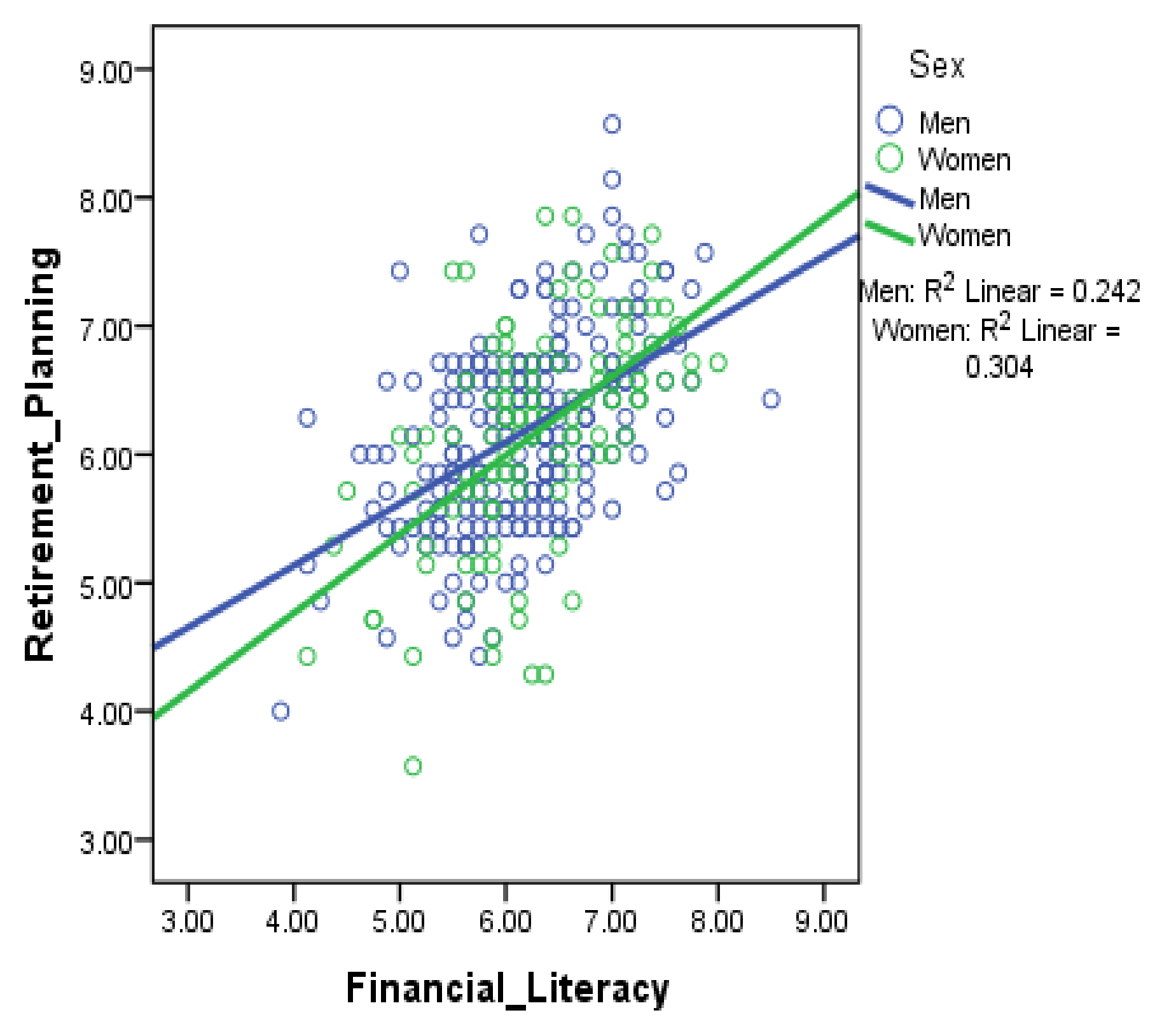
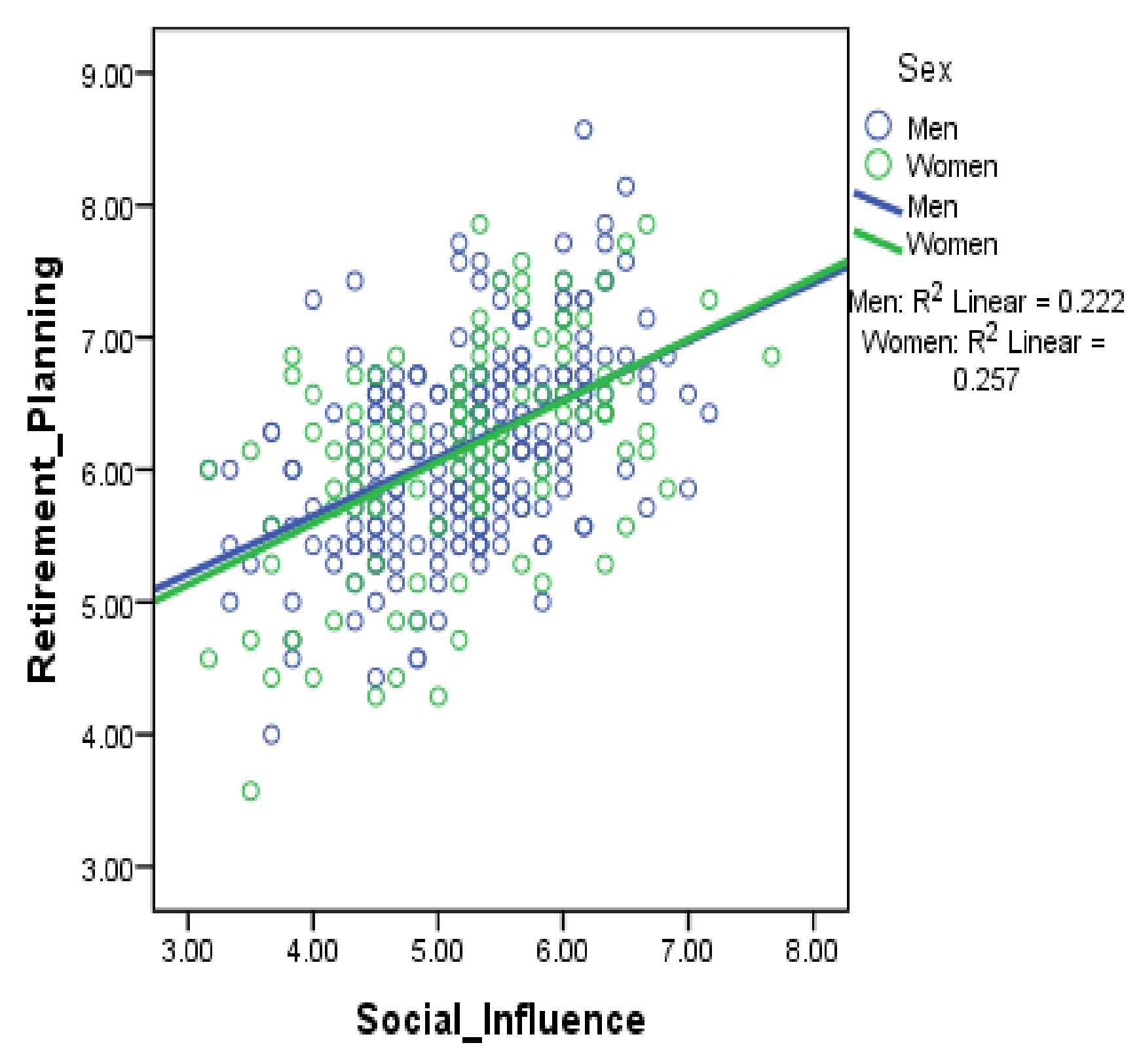
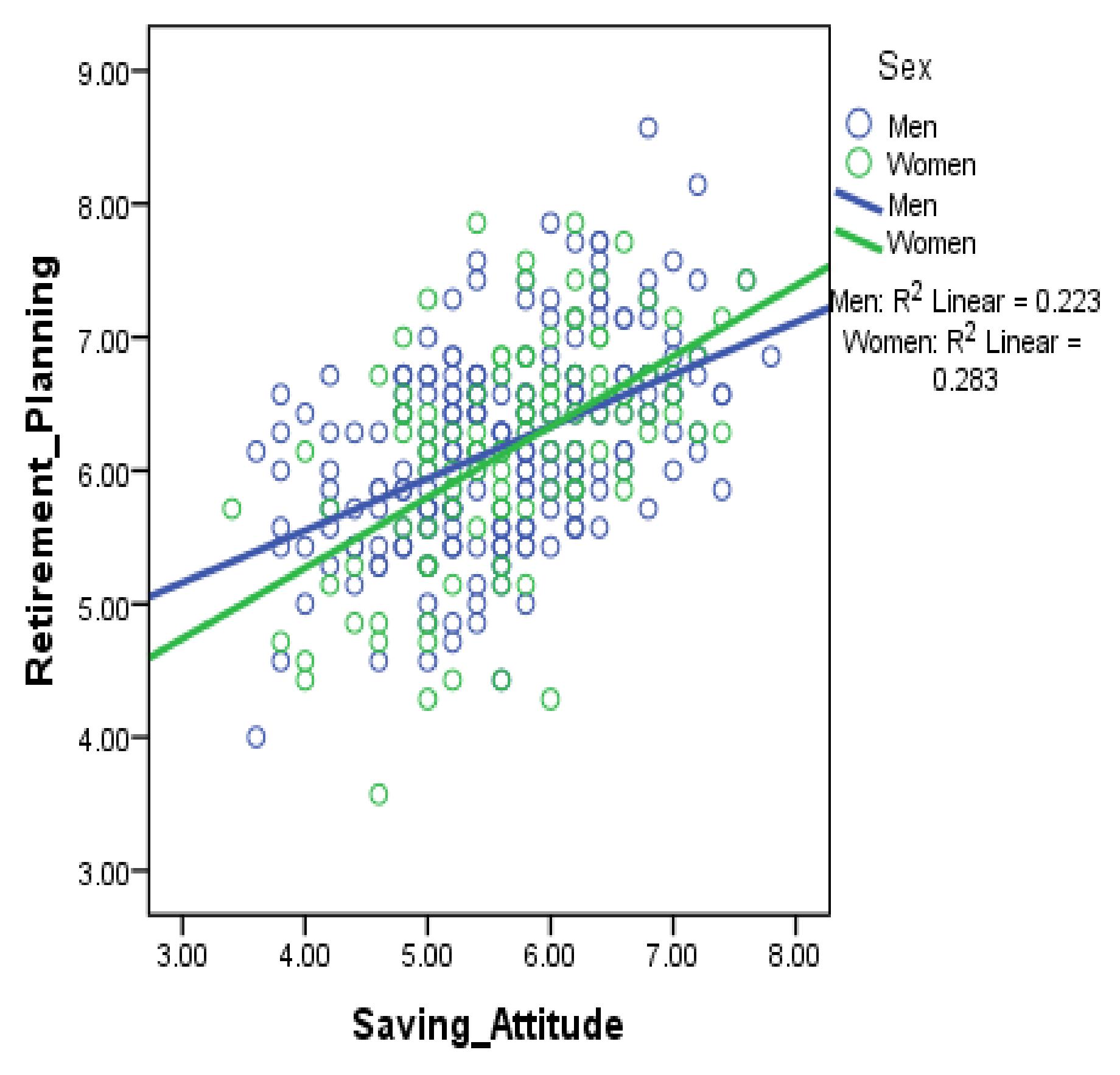
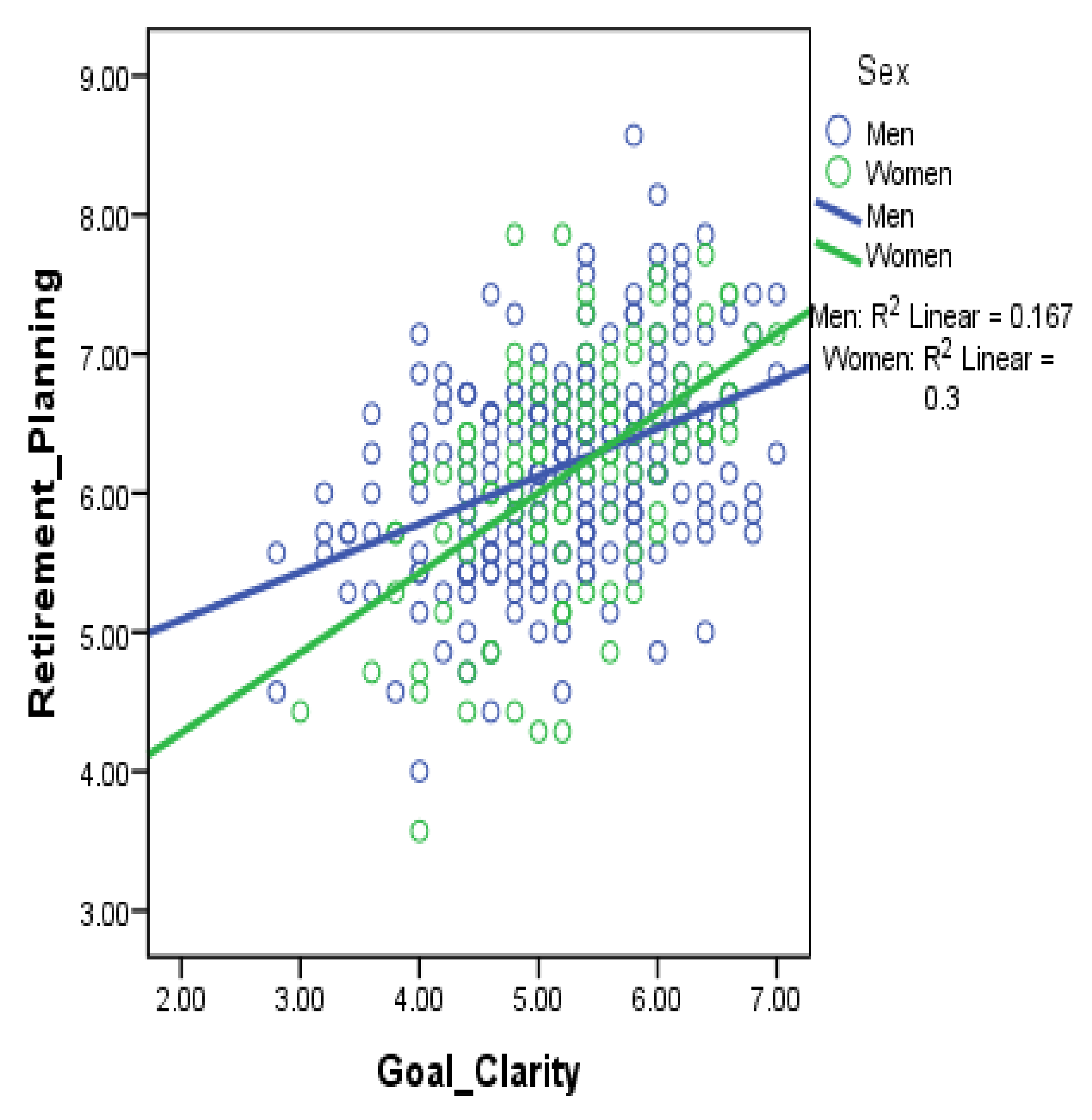

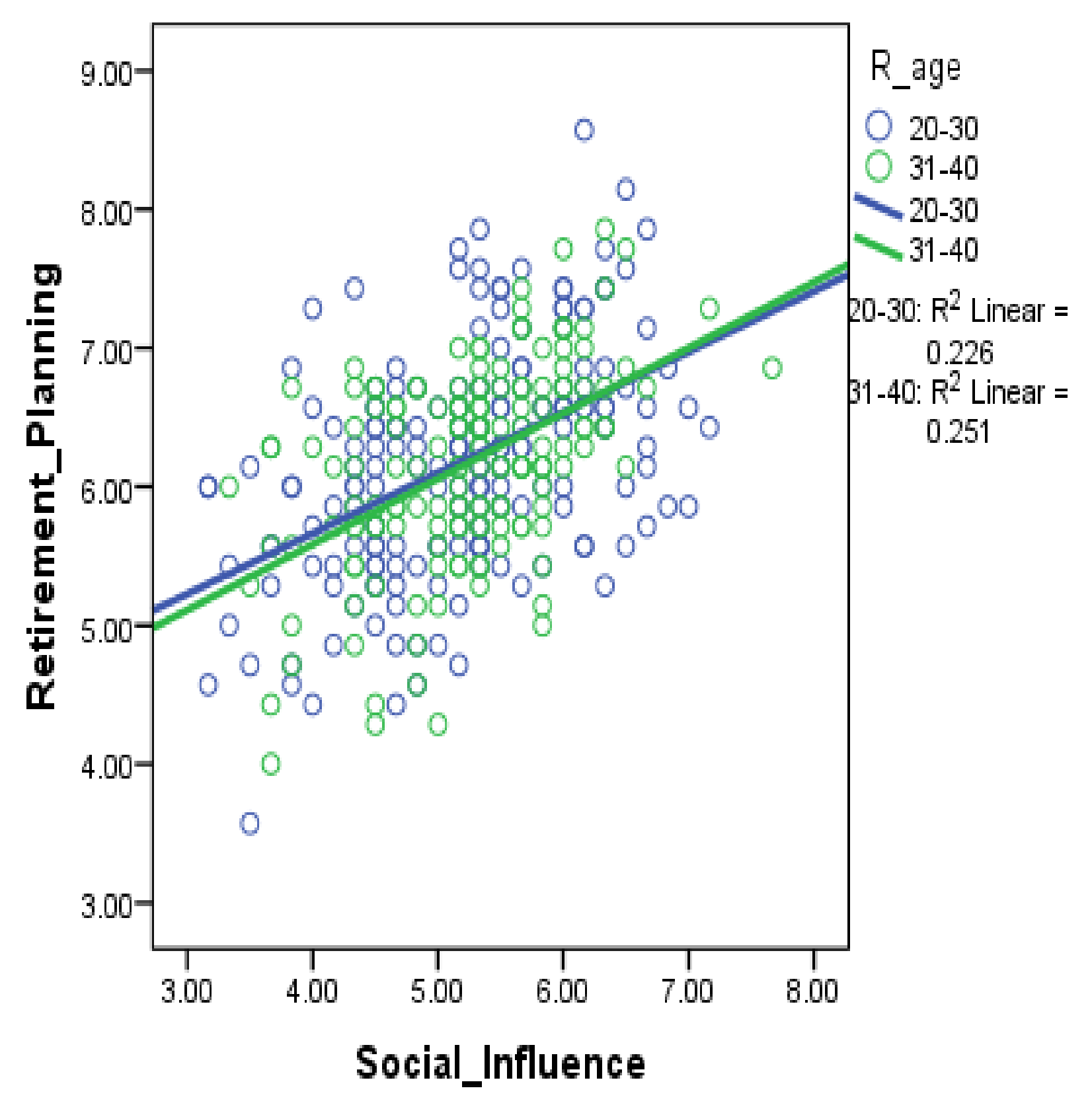
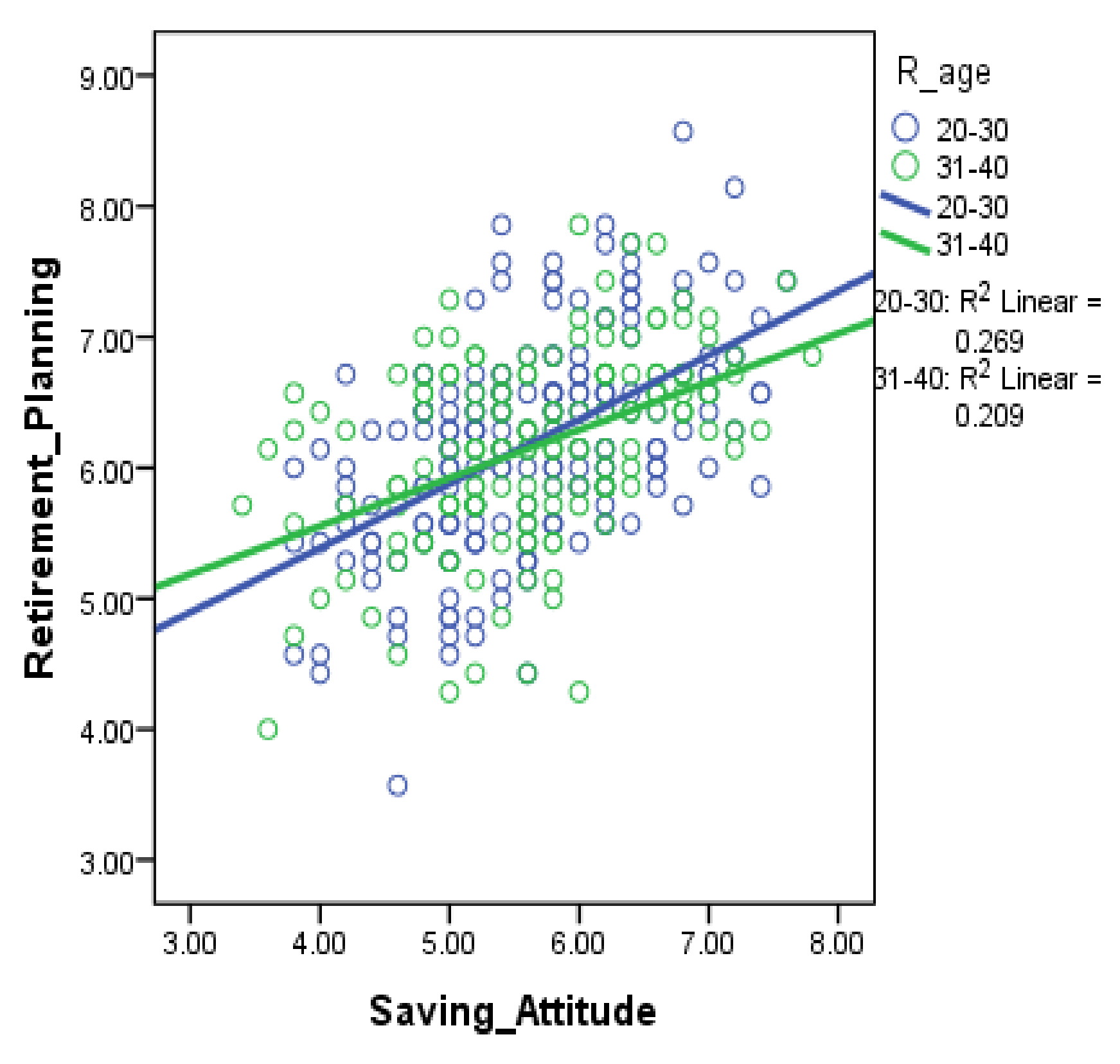
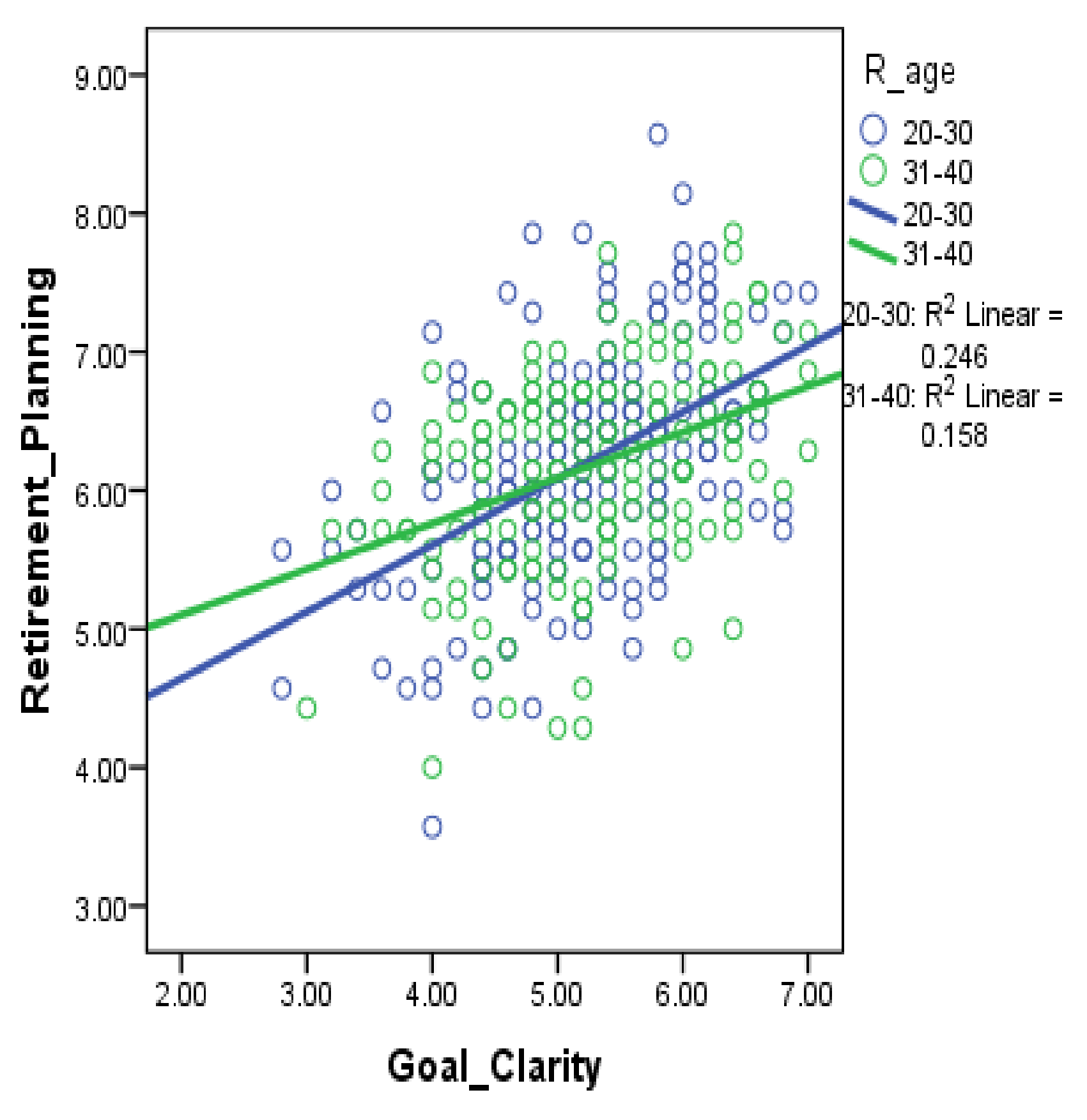
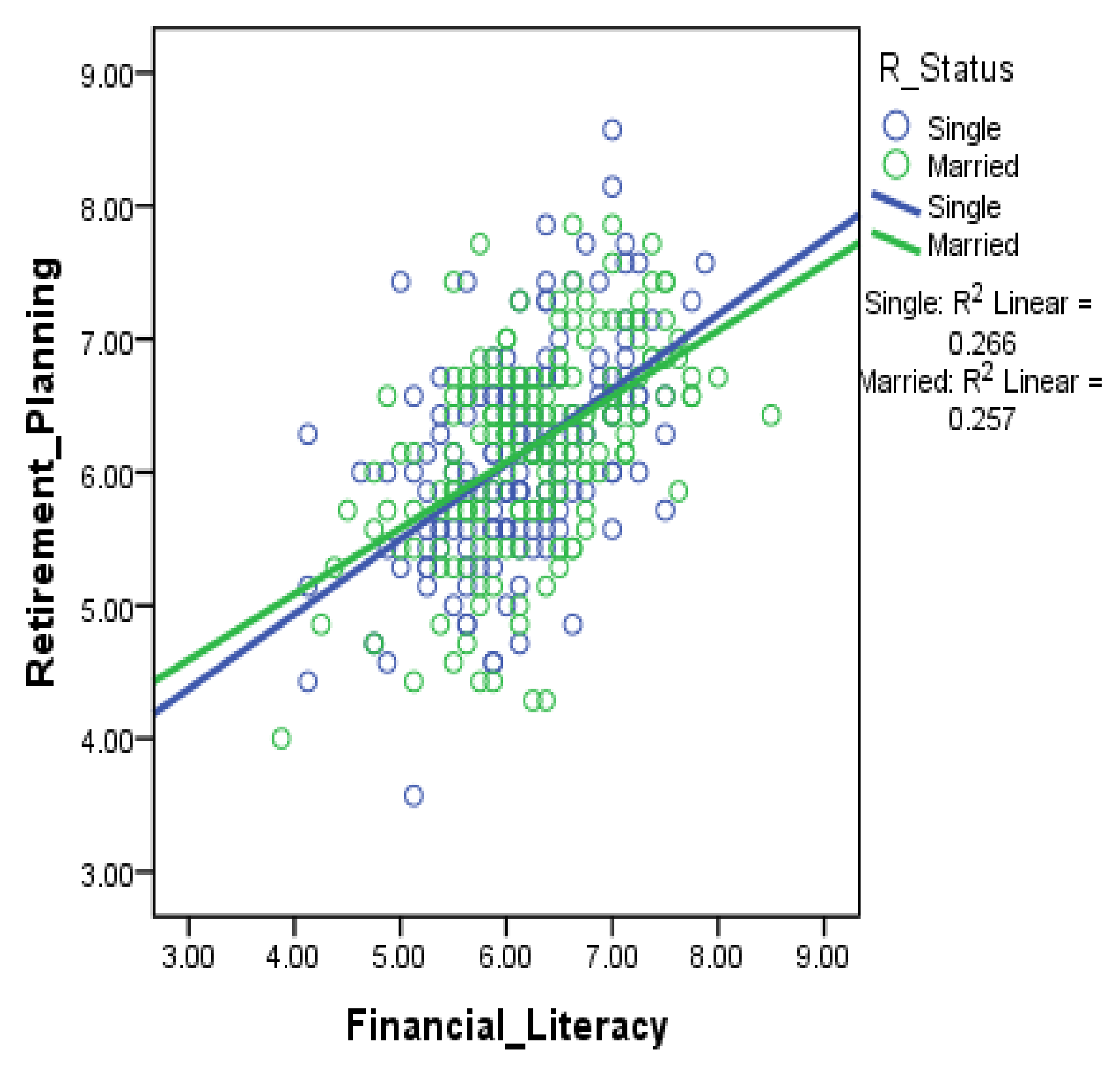
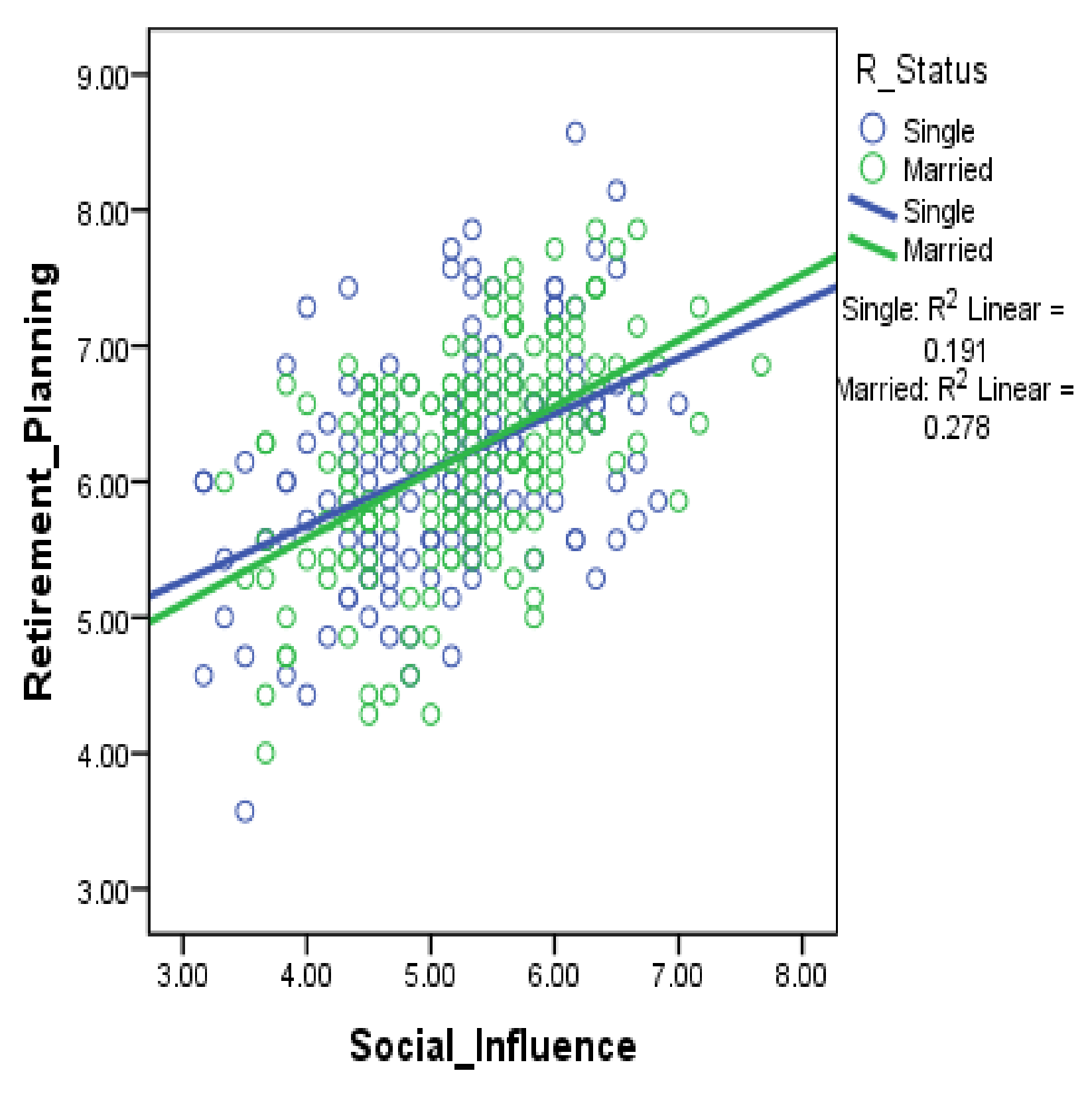




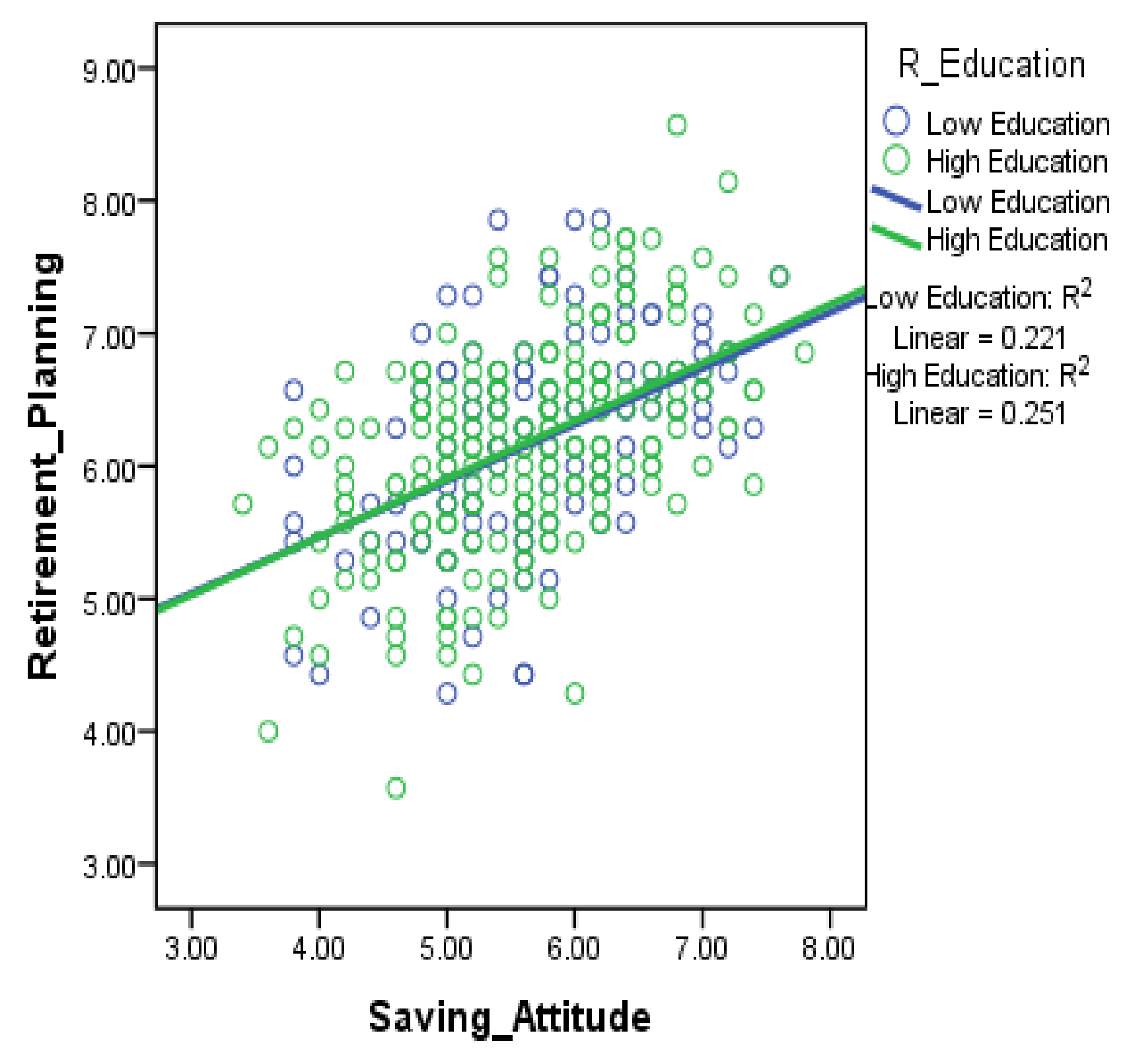

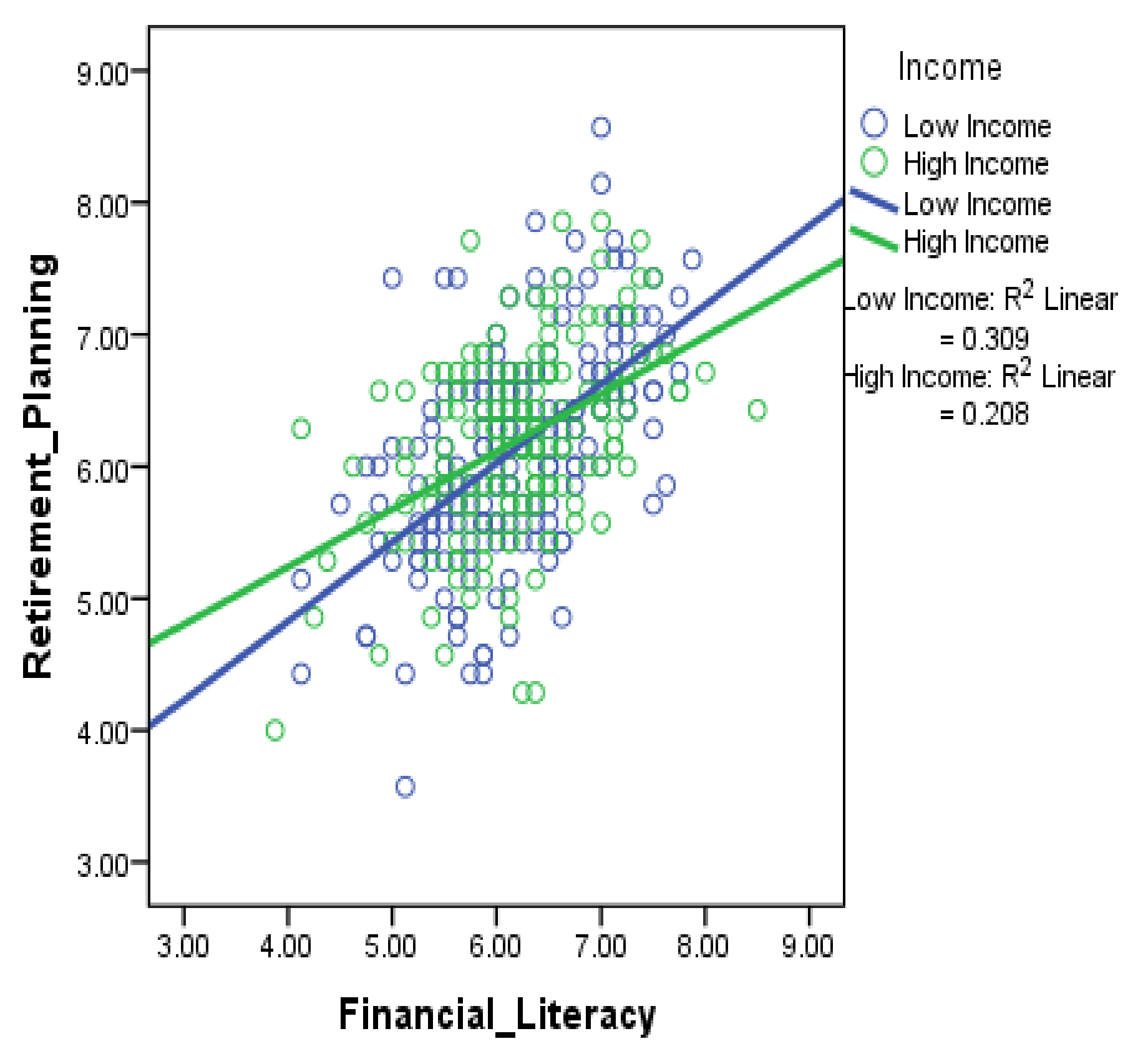
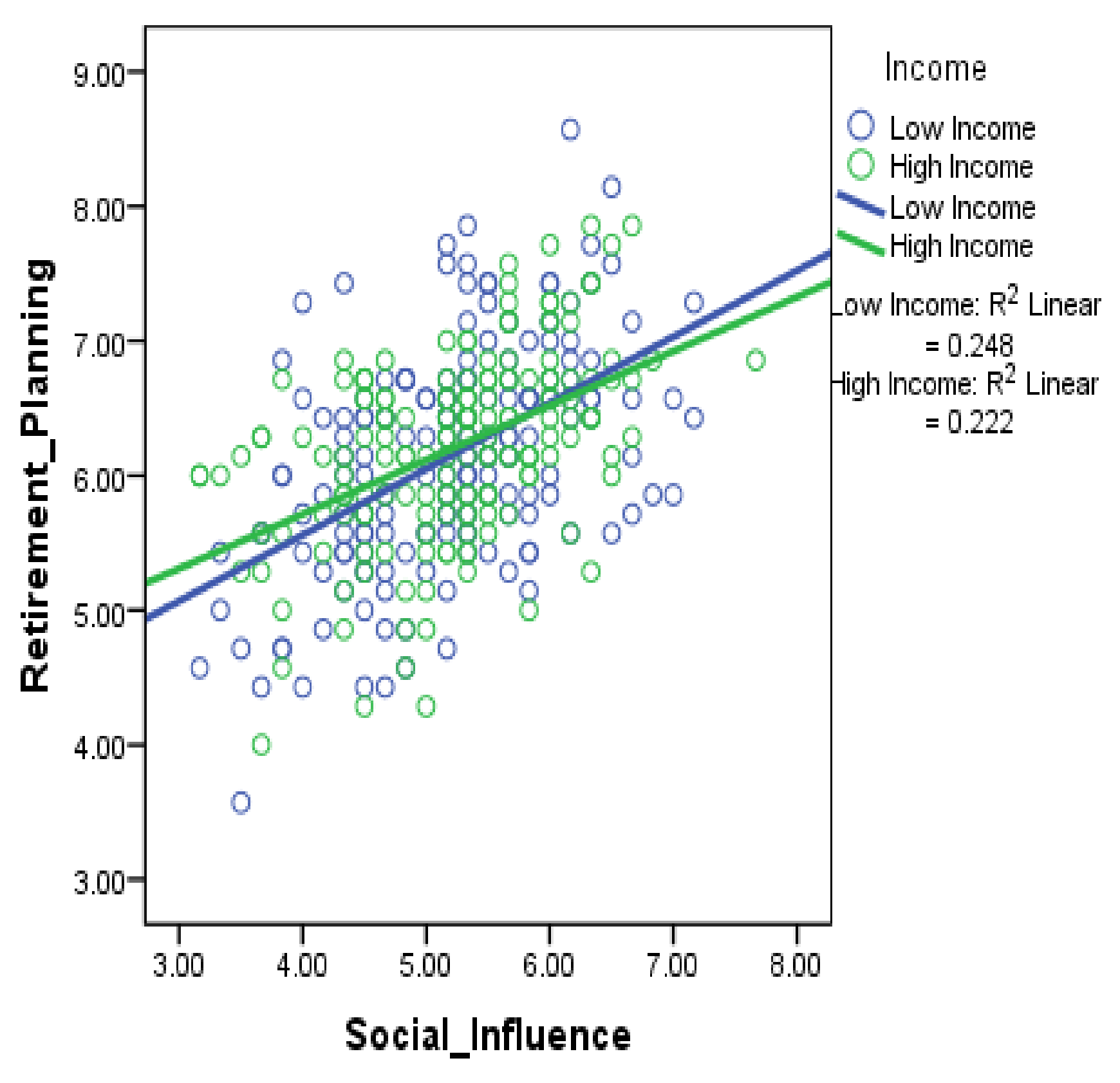
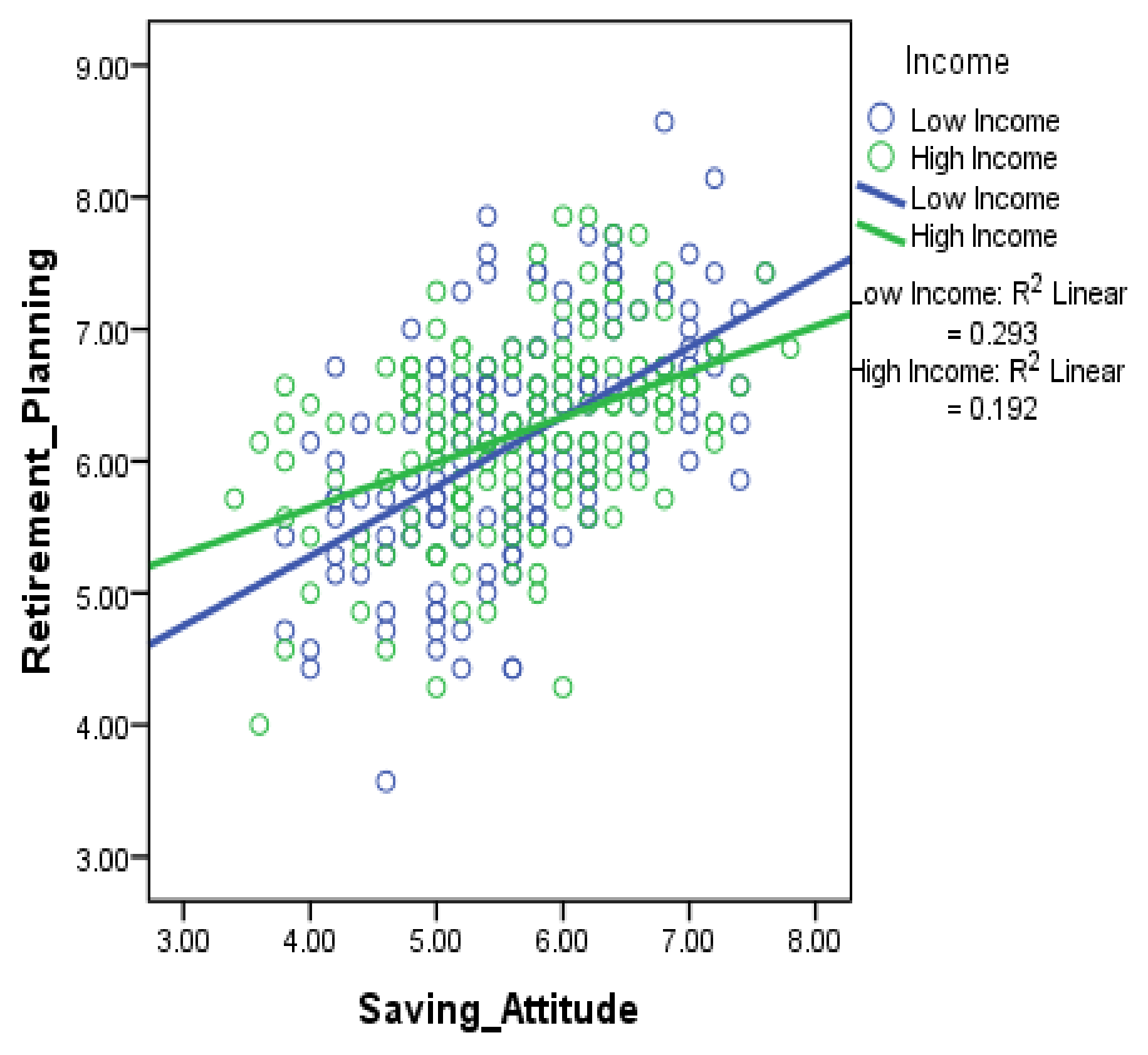

| Variables | Groups | Frequency | Percent (%) |
|---|---|---|---|
| Gender | Male | 195 | 60.37 |
| Female | 128 | 39.63 | |
| Education | Diploma | 65 | 20.12 |
| Bachelor | 172 | 53.25 | |
| Master/PhD | 27 | 8.36 | |
| Others | 59 | 18.27 | |
| Marital Status | Single | 202 | 62.54 |
| Married | 121 | 37.46 | |
| Age | 21–30 | 134 | 41.49 |
| 31–40 | 189 | 58.51 | |
| Income | Less than RM1500 | 25 | 7.74 |
| RM1501 to RM4000 | 109 | 33.75 | |
| RM4001to RM6500 | 155 | 47.99 | |
| RM6501 and above | 34 | 10.53 |
| Item | Loading | CR | AVE | Mean | SD |
|---|---|---|---|---|---|
| Financial Literacy | 0.897 | 0.521 | 6.215 | 0.745 | |
| If monthly income is RM 1000, it is advisable to save only RM10 per month (1% of monthly income). | 0.700 | 8.546 | 1.000 | ||
| The recommended savings for emergency are 3 to 6 months of total monthly expenses. | 0.720 | 8.991 | 1.003 | ||
| Given the savings interest is 4% per annum, savings of RM200 will accumulate to RM208 at the end of the first year. | 0.730 | 5.737 | 0.957 | ||
| Investing in low risk investments will give a high return. | 0.700 | 5.957 | 0.961 | ||
| Net Asset Values Total Assets minus Total Liabilities. | Excluded | 4.537 | 0.994 | ||
| Given current monthly income is RM1000 and for comfortably living after retirement, it is advisable to have more than RM600 a month after retirement. | 0.750 | 5.434 | 0.999 | ||
| Given that monthly income is RM1000, the total investment payments of all loans may exceed RM600 (>60% of the income). | 0.700 | 5.246 | 0.968 | ||
| Given a loan of RM100.00 within a year, (5% interest per annum), the loan amount payable is RM105.00. | 0.760 | 5.009 | 0.997 | ||
| Given that monthly income is RM1000, the amount that can be spent on entertainment is RM400.00. | 0.720 | 4.803 | 0.939 | ||
| Saving Attitude | 0.891 | 0.620 | 5.647 | 0.865 | |
| I saved first before spending. | 0.760 | 8.483 | 1.037 | ||
| I spend my money accordingly to the plan. | Excluded | 5.625 | 1.005 | ||
| I plan my finances for retirement. | 0.750 | 3.203 | 1.028 | ||
| I invest in legal investment. | 0.800 | 3.503 | 1.040 | ||
| I record all my spending. | 0.840 | 4.491 | 0.989 | ||
| I am preparing a budget. | 0.780 | 5.669 | 1.051 | ||
| Goal Clarity | 0.866 | 0.564 | 5.221 | 0.841 | |
| My financial goal is to get ready for emergency. | 0.770 | 5.957 | 1.041 | ||
| My financial goal is to get return from investment. | 0.740 | 5.343 | 0.997 | ||
| My financial goal is to have comfortable living upon retirement. | 0.810 | 5.166 | 1.076 | ||
| My financial goal is to be prepared if I lose my job. | 0.680 | 4.929 | 1.085 | ||
| My financial goal is to settle debt faster. | 0.750 | 4.709 | 1.022 | ||
| My financial goal is to enjoy a luxurious holiday. | Excluded | 5.012 | 0.887 | ||
| Social Influence | 0.887 | 0.568 | 5.218 | 0.824 | |
| Organized outings/activities with friend/family. | 0.730 | 6.051 | 1.064 | ||
| Called friends or family regularly. | 0.780 | 5.883 | 1.052 | ||
| Emailed friends or family regularly. | 0.700 | 5.483 | 1.023 | ||
| Visited friends or family regularly. | 0.760 | 5.017 | 1.052 | ||
| Made new friends recently. | 0.790 | 5.803 | 0.998 | ||
| Joined/made inquiries about joining a social club or group. | 0.760 | 3.658 | 0.777 | ||
| Retirement Planning | 0.875 | 0.502 | 6.179 | 0.763 | |
| Watched/listened to programs on financial planning. | 0.740 | 6.397 | 1.038 | ||
| Assessed your net worth. | Excluded | 6.211 | 1.025 | ||
| Read books/article/brochures on financial planning. | Excluded | 5.225 | 0.885 | ||
| Spoken to relevant person about postretirement works. | 0.750 | 7.209 | 0.975 | ||
| Discussed financial planning with a professional in the field. | 0.660 | 7.551 | 1.002 | ||
| Exercised regularly (at least twice a week). | 0.640 | 4.486 | 1.037 | ||
| Visited health-related sites on the Internet/Intranet. | 0.780 | 5.637 | 0.977 | ||
| Discussed retirement with retired people. | 0.740 | 5.969 | 1.002 | ||
| Visited websites on postretirement work. | 0.680 | 6.006 | 1.063 |
| Goal Clarity | Financial Literacy | Social Influence | Saving Attitude | Retirement Planning | |
|---|---|---|---|---|---|
| Goal Clarity | 0.751 | ||||
| Financial Literacy | 0.562 | 0.722 | |||
| Social Influence | 0.545 | 0.584 | 0.754 | ||
| Saving Attitude | 0.618 | 0.583 | 0.587 | 0.788 | |
| Retirement Planning | 0.519 | 0.575 | 0.549 | 0.544 | 0.708 |
| Estimate | S.E. | C.R. | p | Result | |||
|---|---|---|---|---|---|---|---|
| Retirement Planning | <--- | Financial Literacy | 0.305 | 0.081 | 3.744 | *** | Significant |
| Retirement Planning | <--- | Saving Attitude | 0.170 | 0.073 | 2.330 | 0.020 | Significant |
| Retirement Planning | <--- | Goal Clarity | 0.145 | 0.071 | 2.030 | 0.042 | Significant |
| Retirement Planning | <--- | Social Influence | 0.207 | 0.069 | 2.992 | 0.003 | Significant |
| Constraint Model | Degree of Freedom | Unconstraint Model | Degree of Freedom | Chi-Square Difference | Result | |||
|---|---|---|---|---|---|---|---|---|
| Men | ||||||||
| Retirement Planning | <--- | Financial Literacy | 486.970 | 425 | 451.851 | 424 | 35.119 | <0.001 |
| Retirement Planning | <--- | Saving Attitude | 493.037 | 425 | 451.851 | 424 | 41.186 | <0.001 |
| Retirement Planning | <--- | Goal Clarity | 505.263 | 425 | 451.851 | 424 | 53.412 | <0.001 |
| Retirement Planning | <--- | Social Influence | 517.748 | 425 | 451.851 | 424 | 65.897 | <0.001 |
| 21–30 | ||||||||
| Retirement Planning | <--- | Financial Literacy | 468.829 | 425 | 442.095 | 424 | 26.734 | <0.001 |
| Retirement Planning | <--- | Saving Attitude | 500.805 | 425 | 442.095 | 424 | 58.71 | <0.001 |
| Retirement Planning | <--- | Goal Clarity | 472.729 | 425 | 442.095 | 424 | 30.634 | <0.001 |
| Retirement Planning | <--- | Social Influence | 469.879 | 425 | 442.095 | 424 | 27.784 | <0.001 |
| Low Income | ||||||||
| Retirement Planning | <--- | Financial Literacy | 476.657 | 425 | 448.381 | 424 | 28.276 | <0.001 |
| Retirement Planning | <--- | Saving Attitude | 487.703 | 425 | 448.381 | 424 | 39.322 | <0.001 |
| Retirement Planning | <--- | Goal Clarity | 483.733 | 425 | 448.381 | 424 | 35.352 | <0.001 |
| Retirement Planning | <--- | Social Influence | 478.083 | 425 | 448.381 | 424 | 29.702 | <0.001 |
| Single | ||||||||
| Retirement Planning | <--- | Financial Literacy | 457.379 | 425 | 443.360 | 424 | 14.019 | <0.001 |
| Retirement Planning | <--- | Saving Attitude | 491.117 | 425 | 443.360 | 424 | 47.757 | <0.001 |
| Retirement Planning | <--- | Goal Clarity | 476.262 | 425 | 443.360 | 424 | 32.902 | <0.001 |
| Retirement Planning | <--- | Social Influence | 458.395 | 425 | 443.360 | 424 | 15.035 | <0.001 |
| Low Education | ||||||||
| Retirement Planning | <--- | Financial Literacy | 515.183 | 425 | 495.663 | 424 | 19.52 | <0.001 |
| Retirement Planning | <--- | Saving Attitude | 521.356 | 425 | 495.663 | 424 | 25.693 | <0.001 |
| Retirement Planning | <--- | Goal Clarity | 522.469 | 425 | 495.663 | 424 | 26.806 | <0.001 |
| Retirement Planning | <--- | Social Influence | 520.017 | 425 | 495.663 | 424 | 24.354 | <0.001 |
| Constraint Model | Degree of Freedom | Unconstraint Model | Degree of Freedom | Chi-Square Difference | Result | |||
|---|---|---|---|---|---|---|---|---|
| Women | ||||||||
| Retirement Planning | <--- | Financial Literacy | 481.398 | 425 | 469.558 | 424 | 11.84 | <0.001 |
| Retirement Planning | <--- | Saving Attitude | 501.941 | 425 | 469.558 | 424 | 32.383 | <0.001 |
| Retirement Planning | <--- | Goal Clarity | 492.851 | 425 | 469.558 | 424 | 23.293 | <0.001 |
| Retirement Planning | <--- | Social Influence | 483.012 | 425 | 469.558 | 424 | 13.454 | <0.001 |
| 31–40 | ||||||||
| Retirement Planning | <--- | Financial Literacy | 515.228 | 425 | 497.588 | 424 | 17.640 | <0.001 |
| Retirement Planning | <--- | Saving Attitude | 511.892 | 425 | 497.588 | 424 | 14.304 | <0.001 |
| Retirement Planning | <--- | Goal Clarity | 543.864 | 425 | 497.588 | 424 | 46.276 | <0.001 |
| Retirement Planning | <--- | Social Influence | 548.799 | 425 | 497.588 | 424 | 51.211 | <0.001 |
| High Income | ||||||||
| Retirement Planning | <--- | Financial Literacy | 476.920 | 425 | 454.242 | 424 | 22.678 | <0.001 |
| Retirement Planning | <--- | Saving Attitude | 484.684 | 425 | 454.242 | 424 | 30.442 | <0.001 |
| Retirement Planning | <--- | Goal Clarity | 494.011 | 425 | 454.242 | 424 | 39.769 | <0.001 |
| Retirement Planning | <--- | Social Influence | 509.410 | 425 | 454.242 | 424 | 55.168 | <0.001 |
| Married | ||||||||
| Retirement Planning | <--- | Financial Literacy | 489.903 | 425 | 455.450 | 424 | 34.453 | <0.001 |
| Retirement Planning | <--- | Saving Attitude | 480.018 | 425 | 455.450 | 424 | 24.568 | <0.001 |
| Retirement Planning | <--- | Goal Clarity | 497.645 | 425 | 455.450 | 424 | 42.195 | <0.001 |
| Retirement Planning | <--- | Social Influence | 525.304 | 425 | 455.450 | 424 | 69.854 | <0.001 |
| High Education | ||||||||
| Retirement Planning | <--- | Financial Literacy | 458.971 | 425 | 435.961 | 424 | 23.01 | <0.001 |
| Retirement Planning | <--- | Saving Attitude | 482.054 | 425 | 435.961 | 424 | 46.093 | <0.001 |
| Retirement Planning | <--- | Goal Clarity | 484.705 | 425 | 435.961 | 424 | 48.744 | <0.001 |
| Retirement Planning | <--- | Social Influence | 485.591 | 425 | 435.961 | 424 | 49.630 | <0.001 |
| No. | Research Hypotheses | Results |
|---|---|---|
| 1. | Financial literacy has a significant effect on retirement planning | Supported |
| 2. | Saving attitude has a significant effect on retirement planning | Supported |
| 3. | Social influence has a significant effect on retirement planning | Supported |
| 4. | Goal clarity has a significant effect on retirement planning | Supported |
| 5. | Gender moderates the relationships between financial literacy and retirement planning | Supported |
| 6. | Gender moderates the relationships between saving attitude and retirement planning | Supported |
| 7. | Gender moderates the relationships between social influence and retirement planning | Supported |
| 8. | Gender moderates the relationships between goal clarity and retirement planning | Supported |
| 9. | Age moderates the relationships between financial literacy and retirement planning | Supported |
| 10. | Age moderates the relationships between saving attitude and retirement planning | Supported |
| 11. | Age moderates the relationships between social influence and retirement planning | Supported |
| 12. | Age moderates the relationships between goal clarity and retirement planning | Supported |
| 13. | Education moderates the relationships between financial literacy and retirement planning | Supported |
| 14. | Education moderates the relationships between saving attitude and retirement planning | Supported |
| 15. | Education moderates the relationships between social influence and retirement planning | Supported |
| 16. | Education moderates the relationships between goal clarity and retirement planning | Supported |
| 17. | Status moderates the relationships between financial literacy and retirement planning | Supported |
| 18. | Status moderates the relationships between saving attitude and retirement planning | Supported |
| 19. | Status moderates the relationships between social influence and retirement planning | Supported |
| 20. | Status moderates the relationships between goal clarity and retirement planning | Supported |
| 21. | Income moderates the relationships between financial literacy and retirement planning | Supported |
| 22. | Income moderates the relationships between saving attitude and retirement planning | Supported |
| 23. | Income moderates the relationships between social influence and retirement planning | Supported |
| 24. | Income moderates the relationships between goal clarity and retirement planning | Supported |
Publisher’s Note: MDPI stays neutral with regard to jurisdictional claims in published maps and institutional affiliations. |
© 2020 by the authors. Licensee MDPI, Basel, Switzerland. This article is an open access article distributed under the terms and conditions of the Creative Commons Attribution (CC BY) license (http://creativecommons.org/licenses/by/4.0/).
Share and Cite
Afthanorhan, A.; Mamun, A.A.; Zainol, N.R.; Foziah, H.; Awang, Z. Framing the Retirement Planning Behavior Model towards Sustainable Wellbeing among Youth: The Moderating Effect of Public Profiles. Sustainability 2020, 12, 8879. https://doi.org/10.3390/su12218879
Afthanorhan A, Mamun AA, Zainol NR, Foziah H, Awang Z. Framing the Retirement Planning Behavior Model towards Sustainable Wellbeing among Youth: The Moderating Effect of Public Profiles. Sustainability. 2020; 12(21):8879. https://doi.org/10.3390/su12218879
Chicago/Turabian StyleAfthanorhan, Asyraf, Abdullah Al Mamun, Noor Raihani Zainol, Hazimi Foziah, and Zainudin Awang. 2020. "Framing the Retirement Planning Behavior Model towards Sustainable Wellbeing among Youth: The Moderating Effect of Public Profiles" Sustainability 12, no. 21: 8879. https://doi.org/10.3390/su12218879
APA StyleAfthanorhan, A., Mamun, A. A., Zainol, N. R., Foziah, H., & Awang, Z. (2020). Framing the Retirement Planning Behavior Model towards Sustainable Wellbeing among Youth: The Moderating Effect of Public Profiles. Sustainability, 12(21), 8879. https://doi.org/10.3390/su12218879







